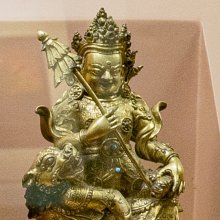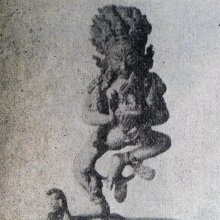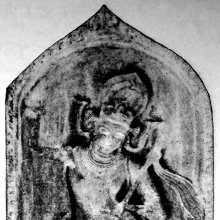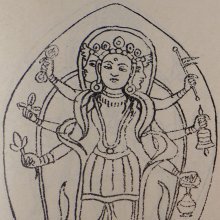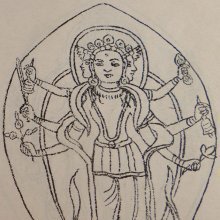Banner: 2 definitions
Introduction:
Banner means something in Buddhism, Pali, Hinduism, Sanskrit. If you want to know the exact meaning, history, etymology or English translation of this term then check out the descriptions on this page. Add your comment or reference to a book if you want to contribute to this summary article.
Images (photo gallery)
(+8 more images available)
In Hinduism
Natyashastra (theatrics and dramaturgy)
Source: Shodhganga: Elements of Art and Architecture in the Trtiyakhanda of the Visnudharmottarapurana (natya)The Banner (or Flag) is denoted by the Sanskrit term Patāka, whereas Patākahasta refers one of the twenty-two Single-hand Gestures (in Indian Dramas) (known as asaṃyuktahastas), according to the Viṣṇudharmottarapurāṇa, an ancient Sanskrit text which (being encyclopedic in nature) deals with a variety of cultural topics such as arts, architecture, music, grammar and astronomy.—The word patāka indicates dhvaja in Sanskrit which means flag or banner. According to the Viṣṇudharmottarapurāṇa in patāka-hasta, all the fingers are straightened and thumb is bent. Abhinavagupta comments in the Abhinavabhāratī that this hand posture is looked like a flag and that is why it is named as patāka. The Viṣṇudharmottarapurāṇa states that the dancer uses the patāka-hasta to obstruct prahāra i.e., strike or beat in a Dance performance. Moreover, to show the blowing of wind and raining, this hand posture is used in Dance. Sometimes eagerness is also denoted with this hand posture.

Natyashastra (नाट्यशास्त्र, nāṭyaśāstra) refers to both the ancient Indian tradition (shastra) of performing arts, (natya—theatrics, drama, dance, music), as well as the name of a Sanskrit work dealing with these subjects. It also teaches the rules for composing Dramatic plays (nataka), construction and performance of Theater, and Poetic works (kavya).
In Buddhism
Mahayana (major branch of Buddhism)
Source: Brill: Śaivism and the Tantric Traditions (mahayana)Banners are used as a material in the performance of a sacred bathing ritual dedicated to Goddess Sarasvatī, according to the seventh chapter of the Suvarṇaprabhāsottamasūtra.—In chapter 7, the Sarasvatīparivarta, the goddess Sarasvatī grants her support to the Dharma preacher through the gift of eloquence, and presents a bathing ritual with enchanted herbs for him and his audience in order to appease all disturbances. It is promised that, invoked by praise, Sarasvatī herself will appear and remove all diseases and difficulties. The ritual instructions prescribe that one should pound herbs and consecrate the powder with mantras at the time of the Puṣya constellation. A maṇḍala should be drawn with cow-dung, flowers should be scattered and gold and silver vessels filled. Four armed men and four well-adorned maidens should be placed there holding pots in their hands, thus accomplishing the protective sealing of the boundaries (sīmābandha). One should use incense, music, umbrellas, flags, banners, mirrors, arrows, spears and dhāraṇī-spells, and in due course bathe behind an image of the Buddha.

Mahayana (महायान, mahāyāna) is a major branch of Buddhism focusing on the path of a Bodhisattva (spiritual aspirants/ enlightened beings). Extant literature is vast and primarely composed in the Sanskrit language. There are many sūtras of which some of the earliest are the various Prajñāpāramitā sūtras.
See also (Relevant definitions)
Starts with: Banner bean.
Ends with: California goldenbanner, Lion banner, Mountain goldenbanner, Santa inez goldenbanner.
Full-text (+784): Dhvaja, Pataka, Vaijayanta, Ketu, Vaijayantika, Vaijayanti, Uccula, Vyomamanjara, Ketana, Kritadhvaj, Dhvajarajin, Akra, Vijayadhvaja, Cihna, Vatadhvaja, Drapsin, Upanandasamjna, Avacuda, Dhammadhaja, Shakraketu.
Relevant text
Search found 150 books and stories containing Banner; (plurals include: Banners). You can also click to the full overview containing English textual excerpts. Below are direct links for the most relevant articles:
Bhagavati-sutra (Viyaha-pannatti) (by K. C. Lalwani)
Part 2 - Air-bodies’ power to transform < [Chapter 4]
Part 1 - More on monk’s power to transform < [Chapter 5]
Part 2 - On monk transforming into horse form, etc. < [Chapter 5]
Warfare and Military System in Vedic Literature (by Rinki Deka)
War-Flag (in the battlefield) < [Chapter 4 - Principles and Ethics related to the Warfare]
Heimskringla (by Snorri Sturlson)
Part 233 - How The Lendermen Set Up Their Banners < [Chapter VII - Saga Of Olaf Haraldson]
Part 24 - Battle At Fredarberg < [Chapter IV - Hakon The Good's Saga]
Part 74 - King Harald's Battle With Earl Hakon < [Chapter IX - Saga Of Harald Hardrade]
Trishashti Shalaka Purusha Caritra (by Helen M. Johnson)
Part 6: Story of the faithful Brāhman < [Chapter I - Brahmadattacaritra]
Part 5: Birth of Puruṣapuṇḍarīka < [Chapter III - Ānandapuruṣapuṇḍarīkabalicaritra]
Part 11: The founding of Dvārakā < [Chapter V - Birth of Rāma, Kṛṣṇa, and Ariṣṭanemi]
Mahabharata (English) (by Kisari Mohan Ganguli)
Section LVI < [Sanatsujata Parva]
Section XLVI < [Goharana Parva]
Section CIV < [Jayadratha-Vadha Parva]
The Great Chariot (by Longchenpa)
Part 3 - The Precious Human Body < [B. Delineating the nature of the freedoms and favors]
Part 3d.2a - The perfect place < [B. The explanation of the kayas and wisdoms]
Part 4a.2 - Meditating on the mandala < [B. The explanation of meditation practice, together with its action of ripening and freeing]
Related products

